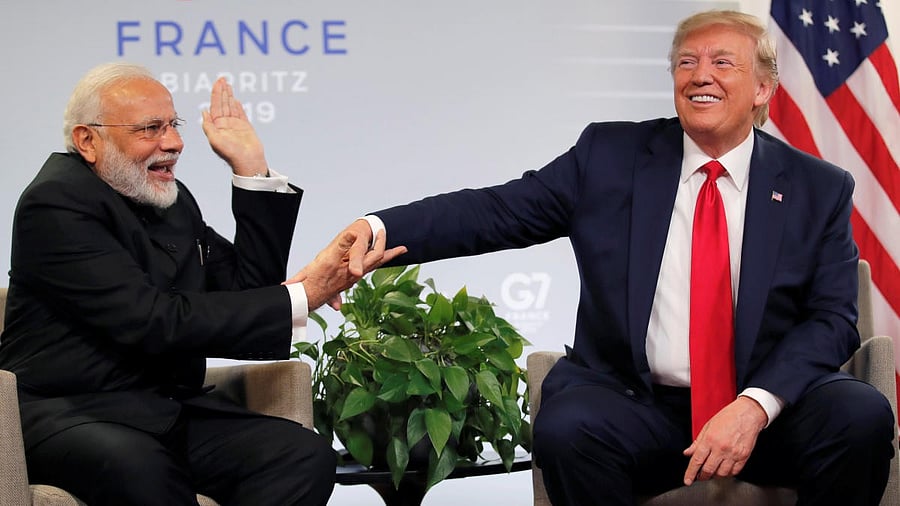
US President Donald Trump meets Indian Prime Minister Narendra Modi.
Credit: Reuters Photo
United States President Donald Trump could not have chosen a worse time from his standpoint to threaten “secondary tariffs” on India if it continues to buy Russian oil.
First, the persuasive consequence of this threat. If Trump’s tariff threat follows its course, he will co-ordinate his actions with Republican Senator Lindsey Graham, who has separately authored a Bill to impose 500% penalties on countries which buy Russian oil, including India. The Bill has co-sponsorship from Senate Democrats too.
When Indian lobbyists go to Capitol Hill to discuss these sanctions, Senators will lend their ears to pleas that India is not a party to the Ukraine war and that Prime Minister Narendra Modi has good relations with Ukraine’s President Volodymyr Zelenskyy. Modi even visited Kyiv. India is in no position to stop the Russia-Ukraine war, so why punish India and damage its relations with the US for no reason or logic? The Bill has clauses for waiver from punitive tariffs. In all likelihood, India will get a waiver, but that is putting the cart before the horse since the Bill itself is a long way from becoming law.
Second, Trump is in the wrong place at the wrong time on the India sanctions threat because in both New Delhi and Moscow, preparations have begun in earnest for Russian President Vladimir Putin’s visit to India this year. Unless there is a cataclysmic escalation in the Ukraine conflict, the 23rd bilateral summit between Modi and Putin will take place in New Delhi soon. India-Russia ties are far too important for the summit to be abandoned by any economic fallout of the US sanctions, howsoever sweeping. There are elements to global diplomacy which are not yet subject to Trump’s whim. The Modi-Putin engagement is one such. Trump was ill-served by his advisers in proposing these secondary sanctions at this juncture. But, being ill-served by aides is nothing new for this US president.
Third, India’s ambassador to Russia, Vinay Kumar, said in a recent interview with Russian media outlet, RT, that “70% of trade turnover between Russia and India is already being serviced in their national currencies.” He predicted that this figure is set to increase. Since the US dollar is not the main currency for the settlement of commodity purchases from Russia, it poses a challenge to US authorities in determining the quantum of Russian oil bought by India. No country buying Russian oil — India, China or Turkey — will certify sua sponte that they are meeting or not meeting Washington’s threshold on secondary tariffs. In the end, purchasers of Russian energy across the world may simply call Trump’s bluff and continue trading with Moscow as they have done all along since the start of the war in Ukraine more than three years ago.
Kumar said India’s oil companies — whose purchase decisions are not controlled by the government — “import oil accrued from whichever sources they find the most competitive, price-wise, and are most sustainable.” That is why, he added, “Russian crude continues to flow into India.”
Minister for Petroleum and Natural Gas Hardeep Singh Puri has said many times that the oil market determines where to buy from. These are not political decisions. It is not as if India is deliberately buying Russian oil to fund the war in Ukraine. Besides, Europe continues to buy petroleum products refined in India, which may or may not include crude sourced from Russia. This is an argument that politicians in Washington will ultimately pay heed to in their conventional wisdom.
Discussions between Moscow and New Delhi have advanced significantly on major arms deals to be inked during Putin’s visit. During the Aero India 2025 in Bengaluru, Russia’s most advanced fighter aircraft, Sukhoi-57, stole the show by mass approval both among experts and the lay viewers of aerobatics. Any doubts in India about Russia’s Sukhoi series have been set at rest after their stellar performance in the Ukraine war. Following the Aero India in February, Russia’s ambassador to India, Denis Alipov, was quoted in the global defence industry media as saying: “We are offering (India) our fifth-generation fighter…not only to sell, but to co-produce. We offer technology sharing.”
Chief of Defence Staff General Anil Chauhan said on July 16 that “in today’s warfare, you can’t win with yesterday’s weapon systems. Today’s warfare has to be fought with tomorrow’s technology.” When hard-nosed negotiations begin with the US on the threatened sanctions, the Trump administration will find itself on a weak wicket because it is hamstrung under its domestic laws from supplying technologies to India, which Russia is offering to share, along with its advanced weaponry. That is how India evaded sanctions in Trump’s first term and bought Russia’s S-400 long-range air defence systems. They proved their worth during the recent Operation Sindoor. That history may well repeat itself with Graham’s sanctions Bill and the president’s 100% secondary tariff threats.
(K P Nayar has extensively covered West Asia and reported from Washington as a foreign correspondent for 15 years.)
Disclaimer: The views expressed here are the author's own. They do not necessarily reflect the views of DH.